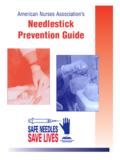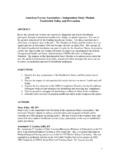Transcription of The Career Ladder Mapping Project
1 December 2002 The Career Ladder Mapping ProjectThe Career Ladder Mapping ProjectShirley Ware Education Center SEIU, Local 250 AFL-CIO(510) 251-1250 20th Street Oakland, CA 94612 Allied Health Project on Career Ladders:Health Career Path Mapping and Worksite Training Development Project3 Health Career Path Mapping and Worksite Training Development ProjectExecutive Summary .. 4 The Project Partners ..6 Health Career Path Mapping and Worksite Training Development 8 Footnotes .. 19 Appendix A - Career Pathways .. 23 Appendix B - Sample Job Descriptions by Pathway 30 Appendix C - Links to 49 Appendix D - Allied Health Survey .. 55 Table of Contents4 Health Career Path Mapping and Worksite Training Development ProjectExecutive SummaryThe Career Ladder Mapping Project is funded by the Center for the Health Professions, University of California, SanFrancisco (UCSF), through grants from the California Endowment and the California Healthcare Foundation.
2 Theproject partnership is comprised of the Shirley Ware Education Center, Service Employees International Union (SEIU)Local 250, AFL-CIO and Kaiser Permanente-Northern California Region. The main goal of the Project is to evaluate and mapcareer paths for 60 hard-to-fill positions within the healthcare setting, using Kaiser Permanente-Northern California Region as amodel. The Project identifies barriers to Career advancement and advises development of Career Ladder training initiatives. Theproject includes a recommended model for work-site-training programs designed specifically to offer entry-level health careworkers Career advancement opportunities within three occupational clusters. These clusters include patient care, technical andclerical classifications. While research for the Project focuses on the Kaiser Permanente model of care, the recommendations areintended to be applicable to the broader healthcare industry. With good reason, media, government and medical professionalshave paid a great deal of attention to the worsening shortage of nurses in the United States.
3 The problem is immense. In 2001,more than one-in-seven hospitals reported a severe shortage of nurses with more than 20 percent of Registered Nurse (RN)positions now standing vacant. The American Hospital Association (AHA) documented 126,000 hospital nursing vacancies in2001. These shortages affect all regions of the country, both rural and urban settings. Since 1998, 60 percent of hospitals sur-veyed by the AHA said recruitment of nurses has become even more no region is unaffected, the problem is more severe in some states. According to the General Accounting Office, Theper capita data that tracks the number of nurses per 100,000 in population rank California 49th out of the 50 states. The growing lack of nurses is only one piece of the picture. Healthcare systems are unable to fill more than 10 percent of theiropen positions for other critical positions such as pharmacists and clinical laboratory scientists. This situation is expected toworsen for other crucial providers such as radiology technicians, who anticipate a growth in demand of 20 percent by are finding it difficult to find qualified workers to fill thousands of other positions from surgical technicians to medicalassistants.
4 The shortages also effect areas outside of direct patient care, including clerical jobs and other entry-level magic bullet exists to fix this severe and growing problem. A large untapped source of new RNs, Licensed Vocational Nurses(LVNs), radiology technicians, medical assistants and surgical technicians is close at hand in the very hospitals suffering theseshortages. This is the pool of workers in entry-level and unlicensed assistant jobs. Given an opportunity, these workers couldascend the health- Career Ladder . Currently they cannot afford to stop working to attend school full-time. These workers often face5 Health Career Path Mapping and Worksite Training Development Projectother obstacles such as limited English proficiency, below average basic skills in English and math, lack of a high schooldiploma, inadequate transportation options, financial or family obligations that prevent them from enrolling in community collegeclasses. A lack of Career counseling at places of employment also contributes to many healthcare workers being unaware of themany Career -advancement opportunities now available to are sympathetic to the idea of on-the-job training, but find it difficult to implement due to a lack of resources, fundingand staff.
5 Once Employers participate in a successful program whether the training is for entry-level workers or RNs the work-site-training model brings benefits to both the employer and the employee. For the employer, the training programs provide a wayto fill positions with workers familiar with the workplace culture. These programs allow employers to diversify their work forcewith minorities and men in an otherwise white, female-dominated field. Work-site-training also creates a feeder system fordepartments that have difficulty recruiting employees for certain hard-to-fill positions. Consequently, this opportunity for ad-vancement generates loyalty among employees that reduces turnover and the cost of recruitment. For the employee it meanscareer advancement, higher income and the enhanced motivation to do a good job. For both employer and employee, all thesebenefits combine to reach the ultimate goal: improved patient demands of implementing effective work-site training in healthcare are myriad.
6 A first step is to map out the pathways bywhich hospital employees can advance their careers. A second step is to develop partnerships with the employers, unions, commu-nity colleges and government to develop and implement programs. A third step is to support employees on their path to careeradvancement by maintaining relationships with the Project Partners and assisting each individual at every step of their careerladder. The partnerships formed are essential to support the work-site-training programs from implementation to placement onthe Career Path Mapping and Worksite Training Development ProjectThe Project PartnersThe Health Care Workers Union, Service Employees International Union Local 250, AFL-CIO affiliate, is the secondlargest healthcare workers union in the nation, the largest in California. An organization of over 85,000 Northern Californiacaregivers, united to achieve better care for our patients and better lives for ourselves and our families.
7 1 Local 250 is at theforefront of the rejuvinated American labor movement, and we are committed to building a strong, effective, diverse anddemocratic voice for working 250 members include certified, licensed and registered nurses, dietary and environmental service workers, paramedics,respiratory therapists, lab technicians, pharmacists, homecare providers, clerical workers and many other classifications who workunder union contracts at approximately 300 Northern California private and public facilities. Local 250 is comprised of sixdivisions including Kaiser Permanente, Acute Care, Convalescent, Home Care and Emergency Medical 250 has been vital to the development of Career pathways. It has created professional and technical councils to providestrength in the profession for needed legislative changes that affect education and the demands of the workforce. In addition, theunion supports programs that aid in all levels of healthcare, beginning with individuals who require English as a Second Language(ESL) or General Education Diploma (GED) Local 250, AFL-CIO started a non-profit organization in 1996, in thememory of former Secretary/Treasurer Shirley Ware, to specifically address the education and Career training needs of Shirley Ware Education Center was founded by the Health Care Workers Union, SEIU, Local 250 in 1998, to provideneeded training for current healthcare workers and to train new workers in response to the healthcare staffing crisis.
8 In the firstfew years of training programs, hundreds of workers have taken advantage of the opportunities offered by the Center. Amongother projects, the Shirley Ware Education Center has developed Certified Nurse Assistant and Career upgrade programs andprovided workers with health and safety education. The center seeks innovative ways to provide entry-level opportunities inhealthcare. In the community, the Shirley Ware Education Center works with other agencies to train and/or retrain potentialhealthcare workers, providing them with the necessary skills for Career Path Mapping and Worksite Training Development ProjectThe Shirley Ware Education Center is a non-profit organization and all of its programs are funded by grants. Funding organiza-tions have included the Occupational Safety and Health Administration, The California State Employment DevelopmentDepartment, the Department of Labor, and the Oakland Private Industry Council (PIC).
9 In 1999, the Shirley Ware Education Center received the Oakland PIC s Excellence in Service award and continues to receiveOSHA to provide needlestick and back injury prevention training to Local 250 Permanente, the largest non-profit health maintenance organization in California serves million members in 11 statesand the District of Columbia. Headquartered in Oakland, California, Kaiser Permanente has been taking care of patients formore 50 years. There are 12 service areas in California which include 28 medical centers with 84,000 employees. The company isbroken down into three entities: the Permanente Medical Groups, Kaiser Foundation Hospitals and Kaiser Foundation HealthPlan, Inc. In 2000, Kaiser Permanente entered into a national labor-management partnership with the unions of the 250, the Shirley Ware Education Center and Kaiser Permanete, in conjuntion with other AFL-CIO affiliates make up theNational Labor Management Partnership.
10 Established in 1997, the goals of this partnership are designed to improve the qualityof healthcare, make Kaiser Permanente a better place to work, enhance Kaiser Permanente s competitive performance, provideemployees with employment and income security, and expand Kaiser Permanente s membership. 2 This was developed to createan atmosphere of collaboration, inclusion and mutual trust. The goals of the company, its employees and members are now oneand the same: To provide quality patient care to Kaiser Permanente members and improve health services for their Career Path Mapping and Worksite Training Development ProjectShirley Ware Education CenterHealth Career Path Mapping and Worksite Training Development Project9 Health Career Path Mapping and Worksite Training Development ProjectThe Public Healthcare CrisisToday s demographics tell an alarming story. Between 2010and 2030, the population will show a six percent declinein the proportion of people aged 18-64.



